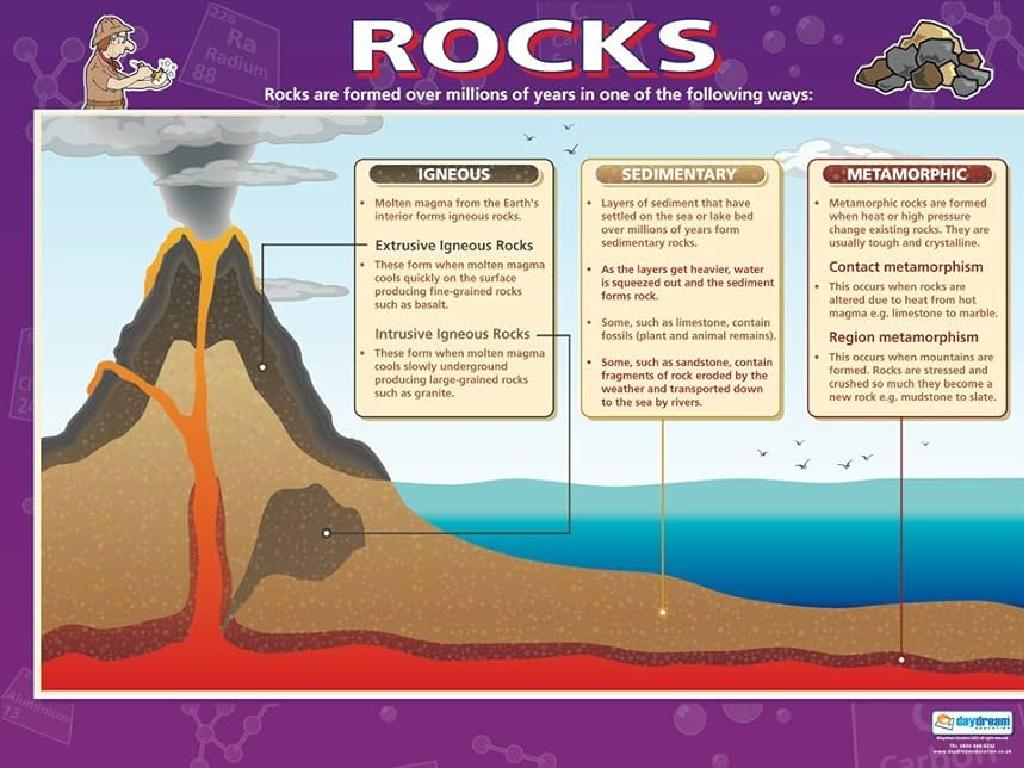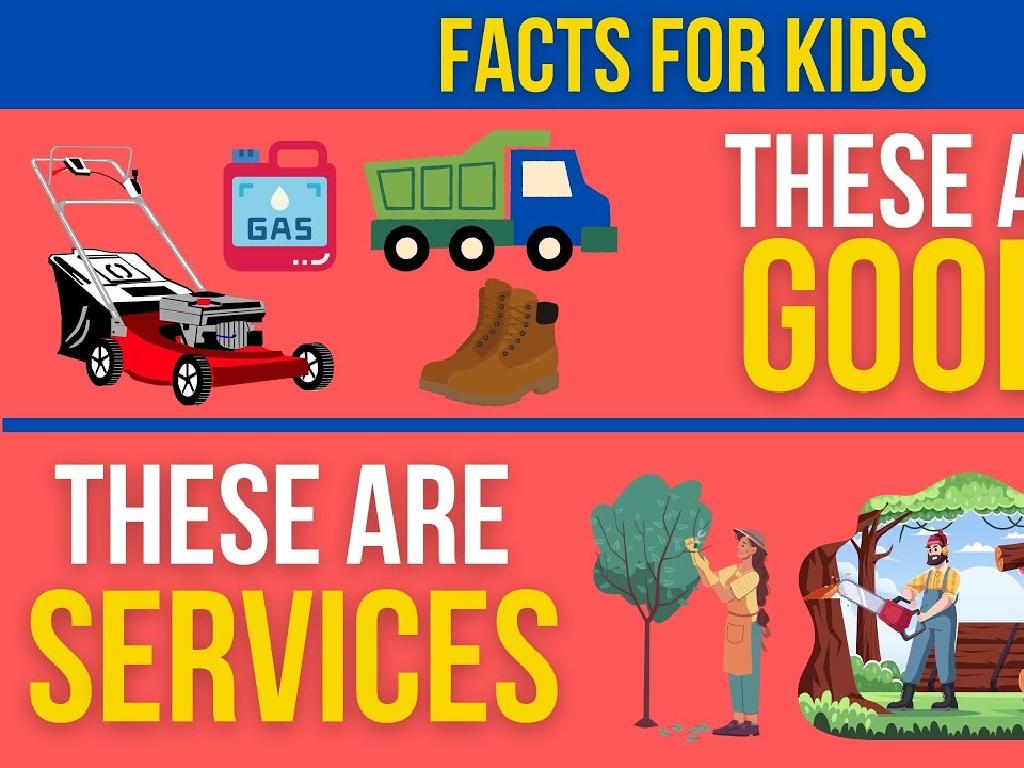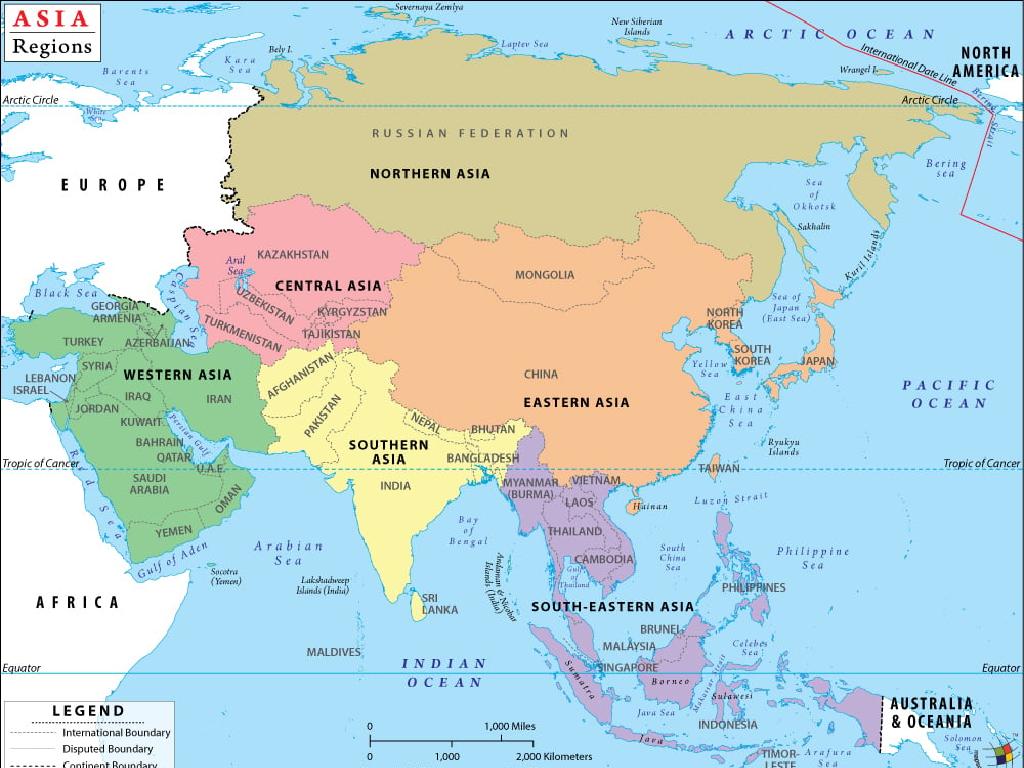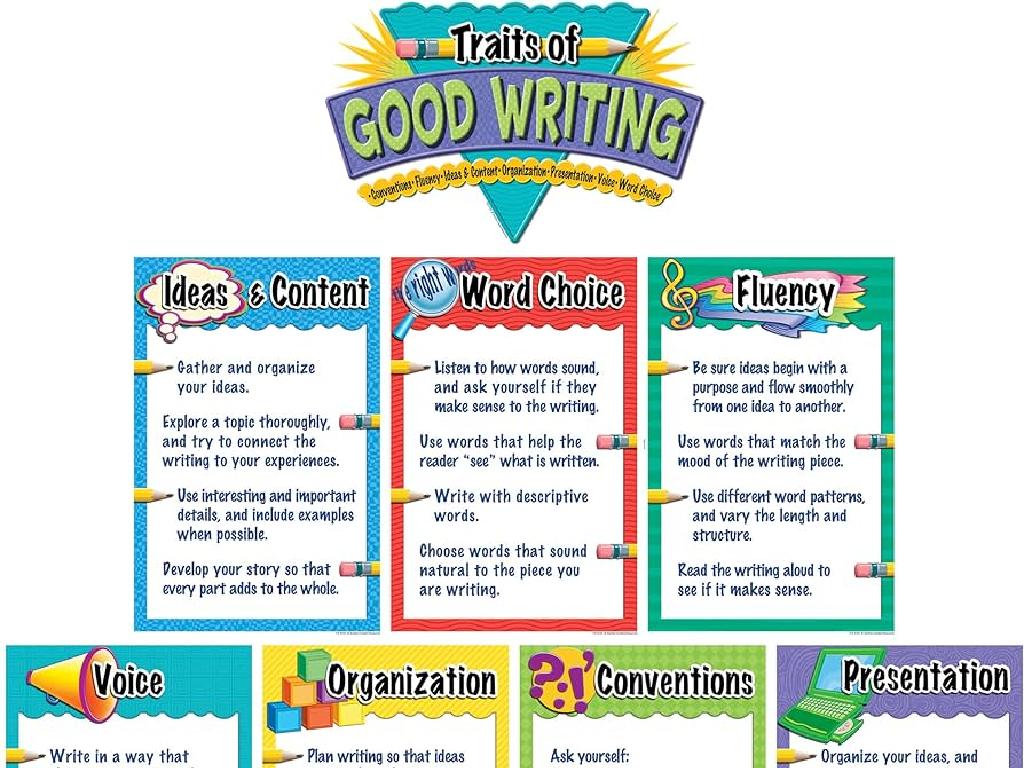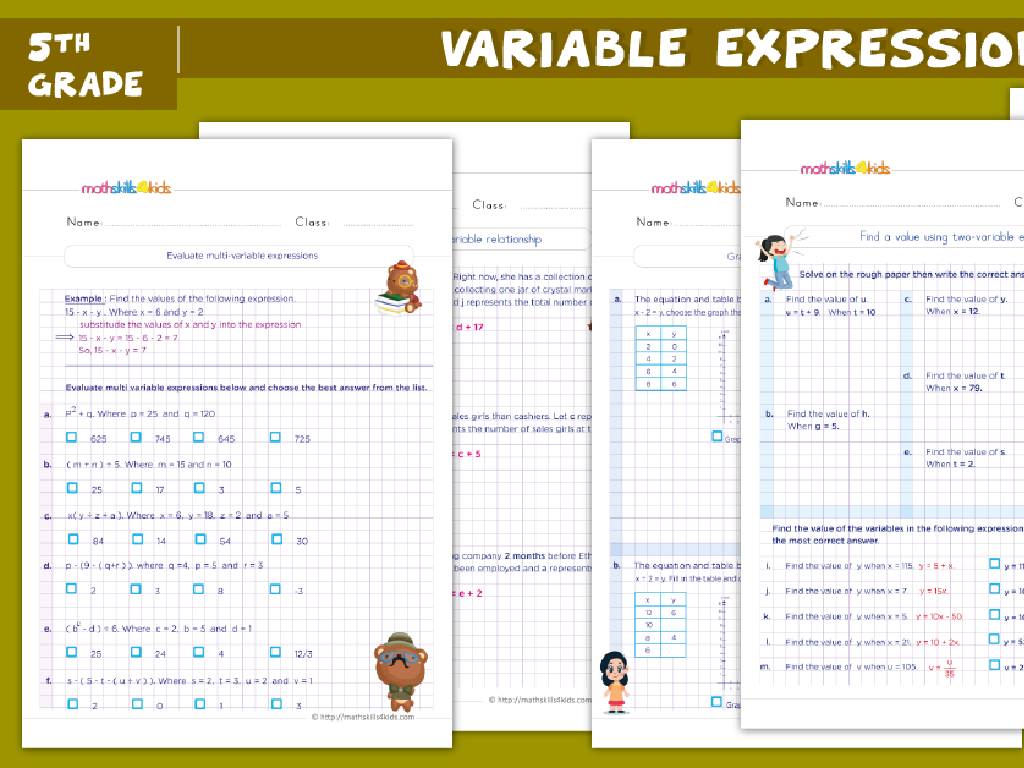How Do Mass And Force Affect Motion?
Subject: Science
Grade: Second grade
Topic: Force And Motion
Please LOG IN to download the presentation. Access is available to registered users only.
View More Content
Exploring How Mass and Force Affect Motion
– Understanding ‘motion’
– Motion is movement; like when you run or a car drives.
– Mass and its role in motion
– Mass is how much ‘stuff’ is in something. Heavier things (more mass) are harder to move.
– Different forces and motion
– Forces are pushes or pulls that can make things start or stop moving.
– Observing motion in action
|
This slide introduces the concept of motion and its relationship with mass and force to second-grade students. Begin by asking the class what they think ‘motion’ means to gauge their prior knowledge. Explain that motion is simply movement, and it can be anything from a person walking to a leaf falling. Discuss how the amount of ‘stuff’ in an object, which is its mass, affects how easy or hard it is to move. Heavier objects need more force to move. Introduce different types of forces like pushes and pulls, and how these forces cause motion. Plan a simple demonstration or class activity where students can observe and discuss how different amounts of force affect the motion of objects with different masses.
Understanding Force
– Force is a push or a pull
– Force makes things move or stop
– Examples of force in action
– Kicking a ball, pulling a door
– How force affects motion
– More force moves things faster
|
This slide introduces the concept of force to second-grade students. Begin by explaining that force is simply a push or a pull. Use relatable examples such as kicking a ball to make it move or pulling a door to open it, which they can easily understand and may have experienced themselves. Discuss how applying force to an object can either set it in motion or bring it to a stop. Emphasize that the amount of force can affect how fast or slow something moves. During the presentation, encourage students to think of other examples where they use force in their daily lives. This will help them connect the concept of force to real-world experiences.
Understanding Mass and Motion
– Mass means how much ‘stuff’ is inside
– Heavier objects have more mass
– Comparing a tennis ball to a basketball
– Notice the size and weight differences
– How mass affects rolling and bouncing
– A basketball rolls farther and bounces higher than a tennis ball because it has more mass
|
This slide introduces the concept of mass and its effect on motion to second-grade students. Begin by explaining that mass is a measure of how much ‘stuff’ or material is in an object. Use relatable examples like comparing the mass of a tennis ball to a basketball, which they can easily visualize. Highlight that heavier things have more mass. During the class, you can have the students hold and feel the weight of a tennis ball and a basketball to understand the concept of mass practically. Explain that objects with more mass, like a basketball, will roll farther and bounce higher than lighter objects with less mass, like a tennis ball, due to the amount of ‘stuff’ inside them. This tangible comparison will help solidify their understanding of how mass affects motion.
Exploring Force and Motion
– More force makes things move faster
– Force on different objects
– Using the same push, do different things move the same way?
– Will a pencil and chair move the same?
– Compare how a small pencil and a big chair move with a push
– Observing motion
|
This slide introduces the basic concepts of force and motion to second graders. Start by explaining that when we push or pull something, that’s called force, and it can make things move or stop. The harder we push or pull, the faster the object can move or the farther it can go. Then, pose a question to the class to think about how different objects might move with the same force. Use a pencil and a chair as examples and ask the students to predict what will happen if they both are pushed with the same strength. This will lead to a discussion or a demonstration to show that objects with different masses (a light pencil versus a heavy chair) move differently even with the same amount of force. This helps students understand that the mass of an object affects how it moves when a force is applied.
How Mass Affects Motion
– More mass means harder to move
– Mass is how much stuff is in an object. Heavier objects are harder to start moving or stop.
– Comparing full vs. empty cart
– Think about when you help with groceries. Is it easier to push the cart when it’s empty or when it’s full of food?
– Pushing different carts
– We’ll try pushing carts with different weights to see how mass changes the way things move.
|
This slide introduces the concept of mass and its effect on motion to second-grade students. Begin by explaining that mass refers to the amount of ‘stuff’ in an object, which can make it heavy or light. Use the example of a shopping cart to illustrate the point that heavier objects (a full cart) require more force to move than lighter objects (an empty cart). To make this concept interactive, consider organizing a class activity where students can push objects of varying masses to experience firsthand how mass affects motion. Encourage them to observe and discuss the differences in effort needed to move each object.
Let’s Experiment with Motion!
– Toy car experiment setup
– Add different weights to cars
– We’ll use small objects like coins to add weight
– Predict motion with same push
– What do you think will happen if we push all cars equally?
– Observe and record results
|
This slide introduces a hands-on class activity involving toy cars to demonstrate how mass and force affect motion. The experiment will require the students to add varying weights to toy cars and predict the outcome of pushing each car with the same amount of force. Before the experiment, discuss with students how they think the weight of an object might change the way it moves when pushed. During the experiment, ensure each student or group has a turn to push the cars and observe the differences in motion. After the activity, have a discussion about their observations and what they learned about force and motion. Possible activities include using different-sized cars, pushing uphill vs. downhill, or using different surfaces to push the cars on.
Experiment Observation: Mass and Motion
– Lighter car moves faster
– Less weight makes it easier to move quickly
– Heavier car moves slower
– More weight means more resistance to movement
– Same force applied to both
– Motion affected by weight
– Weight can change how fast or slow an object moves
|
This slide is meant to help students observe the outcomes of an experiment involving two cars of different masses. The experiment should demonstrate that when the same amount of force is applied, the car with less mass moves faster than the car with more mass. This is because lighter objects require less force to change their motion compared to heavier objects. The concept of inertia can be introduced here, explaining that an object with more mass has more inertia and thus resists changes to its motion more than an object with less mass. Encourage students to think about other examples where they have seen this principle in action, such as pushing a light toy car versus a heavy toy car.
Force, Mass, and Motion in Our World
– Examples of using force
– Pushing a toy car vs a real car
– Mass and movement
– A full backpack is harder to lift than an empty one
– Heavier vs Lighter objects
– Does a soccer ball or a tennis ball go farther when kicked?
– Real-life force application
– Pulling a wagon with one friend inside vs two friends
|
This slide aims to help students understand the concepts of force, mass, and motion by relating them to everyday experiences. Start by discussing what force is and how we use it to move objects, like pushing a swing or kicking a ball. Explain that mass is how much stuff is in an object, and it affects how easy or hard it is to move that object. Heavier objects (greater mass) need more force to move than lighter ones. Use examples like lifting a heavy backpack versus a light one, or the difference in distance a soccer ball travels versus a tennis ball when kicked with the same force. Encourage students to think of their own examples and share them with the class. This will help them grasp the relationship between mass, force, and motion in a tangible way.
Class Activity: Push and Pull!
– Play ‘Tug of War’ game
– Feel the force of pulling
– Notice effect of more mass
– It’s harder to pull when the opposing team is heavier
– Discuss the experience
|
This activity is designed to give students a practical understanding of how mass and force affect motion. ‘Tug of War’ is a fun way for them to experience the force of pulling directly. As they play, prompt them to observe how the mass of the teams affects the game’s outcome. It’s a great opportunity to discuss concepts like resistance and force. After the activity, lead a discussion where students can share what they noticed, especially how a team with more mass requires more force to be moved. This will help them grasp the relationship between mass, force, and motion in a tangible way. Prepare alternative activities such as pushing objects of different masses or arm wrestling to accommodate different class sizes or physical abilities.
Conclusion: Mass, Force, and Motion
– Mass and motion connection
Heavier objects (more mass) are harder to start moving and to stop.
– Force’s role in movement
Force is a push or pull that can make things move or stop.
– Why some things are tough to move
It’s harder to move heavy things because they have more mass.
– Review with examples
|
In this lesson, we’ve learned that an object’s mass (how heavy it is) affects how it moves. When we apply force (a push or pull), it can cause an object to start moving, change direction, or stop. However, the more mass an object has, the more force it takes to change its motion. This is why it’s harder to push a full shopping cart than an empty one. During the review, use examples like pushing different sized balls or toy cars to illustrate these concepts. Ask the students to think of times they had to use more force to move heavier objects and share their experiences.
Homework Challenge: Motion and Play
– Try moving objects of different sizes
– Observe how pushing or pulling affects them
– Does it move easily or is it hard? Why?
– Draw or write your observations
– Use pictures or words to show what happened
– Think about effort needed for each object
– Compare how hard you pushed or pulled
|
This homework activity is designed to help students understand the concepts of mass and force through real-world interaction. By trying to move objects of different sizes and weights, they will observe that heavier objects (greater mass) require more force (pushing or pulling) to move. Encourage them to take note of how much effort it takes to move each object and whether it moves a little or a lot. This will help them grasp the relationship between mass, force, and motion. When they draw or write about their experience, they are reflecting on their learning and solidifying their understanding. In the next class, discuss their findings and relate them back to the scientific concepts of force and motion.

